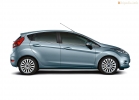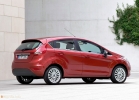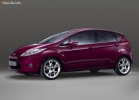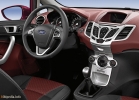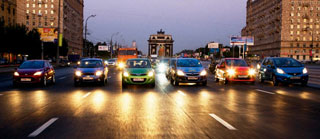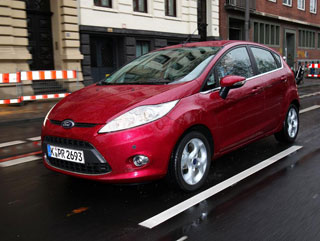Test drive Ford Fiesta 5 doors since 2008 hatchback
Twice joy
 Fun to Drive, Fun to look At these phrases uttered at presentations by someone from the foreign representatives of the Ford company, representing the new, already seventh generation of Fiesta, could be perceived as another marketing move
Fun to Drive, Fun to look At these phrases uttered at presentations by someone from the foreign representatives of the Ford company, representing the new, already seventh generation of Fiesta, could be perceived as another marketing move What is Fun to Drive in the next room stands on the pedesta chassis, no revelations, a 1.6-liter motor, an ordinary handle of five steps, McPherson, a twisting beam, brakes-backbone in the back. It resembles the VAZ eight twenty years ago. Fun to look AT? Well, what could be funny in the design of a car car in the size of a large washing machine, even if this design is kinetic?
Perhaps this is how I would have thought if the Fords decided to hold a presentation before the start of the test drive. But, fortunately, everything happened the other way around. We rolled enough along Tuscan roads, where long straight lines are not in honor, where the turns cling one after another, and even equipped with the correct profile. And each time, noting an interesting place for a photo shoot against the backdrop of magnificent landscapes and leaving the camera from the car, we understood that the appearance of Fiesta can only be appreciated in open spaces. When it is locked (whether in a show room or even in the giant pavilion of the automobile exhibition), the baby does not look at half of her real charm! Therefore, the complements that the developers poured into the address of their brainchild did not seem empty words, we ourselves thought too!
Ford Fiesta The first model of the company, created in the framework of the so -called global product development system (GPDS). Thanks to which the car will be sold on all continents. About ten years ago, the very idea of \u200b\u200ba worldwide small machine seemed strange. In the east, the market of foreign cars was very narrow, and in America the people traditionally had a dislike for cars, which could not be loaded with the whole family and at least twenty suitcases with belongings. But time passed, somewhere the economic situation changed, somewhere the worldview turned out that the compacts became necessary for the whole world. This is what they think in Ford. Not without reason!
 At the same time, the company's specialists understand that in different parts of the world their own requirements for controllability. Therefore, Fiesta for Europe will differ from the fiesta for China or for the United States. With the help of individual suspension settings and control electronics, machines will give an individual character. I have no doubt that the Fords will succeed. The proof of my words FIEST itself. The company's engineers managed to create excellent cars excellent from each other as part of the European model range. Here, for example, is a three -door in the Sport version. Her behavior on the road is significantly more acute than that of the usual five -door modification. Subtle setting! The most powerful 120-horsepower engine, the wheels per inch larger, the suspension is lower and tougher. Sport is justified. FIEST in this configuration is a small provocateur!
At the same time, the company's specialists understand that in different parts of the world their own requirements for controllability. Therefore, Fiesta for Europe will differ from the fiesta for China or for the United States. With the help of individual suspension settings and control electronics, machines will give an individual character. I have no doubt that the Fords will succeed. The proof of my words FIEST itself. The company's engineers managed to create excellent cars excellent from each other as part of the European model range. Here, for example, is a three -door in the Sport version. Her behavior on the road is significantly more acute than that of the usual five -door modification. Subtle setting! The most powerful 120-horsepower engine, the wheels per inch larger, the suspension is lower and tougher. Sport is justified. FIEST in this configuration is a small provocateur! It was necessary to have the courage to arrange a presentation of a car on the rural paths of Italy narrow, bizarrely winding. Not every car will show itself from the best side in such conditions. But there is nothing to be afraid of the new fiesta is her element. It provokes everyone from appearance with a large rear spoiler and ending with the amazing tenacity of the chassis. In each new turn I want to go faster and faster. And you do not need to be afraid of the car obedient and has the right, soft front -wheel drive habits. Even a kettle will be able to move from a slight insufficient rotation at the entrance to an excess, instinctively letting go of the gas.
And what are the response to work by the accelerator! Despite the fact that the engine meets the requirements of Euro 4, there is no question of sluggish reactions to pressing the gas pedal. And if you like not only to add gasoline into the cylinders, but also the adrenaline in the blood, then each time you will cause this easy skidding of the rear axle with a clear discharge of fuel supply and turning the steering wheel. And at the exit, the minimum correction of the course, gas to the floor, and under the fun and pleasant song of the fiesta motor is carried forward to the next turn. And so a kilometer per kilometer, turn over a bend. Refined automobile pleasure! Fun to Drive without flaws. Look, Shura, what can be done from the usual Singer sewing machine. The simplicity of the design, due to the need for a low price in this class of cars, did not affect the honed controllability.
 A turbodiesella modification cooled a little. TDCI motor with a volume of 1.6 liters and a capacity of 90 liters. With. You can not call the wealth weak for a ton. But compared with a gasoline lighter of the same volume, he is openly bored. Fun disappears somewhere. There is no longer any need to stick the thrust reduced before turning and above the roof. And the sound of release here, let's say, is functional. In addition, he is often blocked by the diesel grumbling. So you grumble calmly. Screech with tires? Back. Such a fiesta is phlegmatic and calls the buyer with other values, all the economic sense.
A turbodiesella modification cooled a little. TDCI motor with a volume of 1.6 liters and a capacity of 90 liters. With. You can not call the wealth weak for a ton. But compared with a gasoline lighter of the same volume, he is openly bored. Fun disappears somewhere. There is no longer any need to stick the thrust reduced before turning and above the roof. And the sound of release here, let's say, is functional. In addition, he is often blocked by the diesel grumbling. So you grumble calmly. Screech with tires? Back. Such a fiesta is phlegmatic and calls the buyer with other values, all the economic sense. But everyone has one unchanging Fun on all that very to look at. After all, not so often cars in this segment are bought to realize their driver ambitions. Most are quite enough cute face. And the Fords did not count on this last. In general, it is necessary not to choose a fiesta with a brain armed with a calculator, but by the soul and a sense of beautiful. The main thing is to forget at the time of purchase that for comparable money, instead of this baby, you can take Focus or Fusion. Well, if you have not forgotten, then you are in a different joy and in the other hand.


FOR YOUR INFORMATION
32 years of fiesta
Despite the fact that Henry Ford clearly did not like small cars, on December 3, 1973, the board of directors of Ford Motor Company at the head made a positive decision on the Bobcat project. It was decided to give the name Fiesta the name of the first in the history of Ford with the transverse location of the engine at the end of 1975. And in 1976, the first generation (Mark I) was the first low-profile from Ford on the conveyor.
Three-door hatchbacks were equipped with 4-cylinder engines 1.0 liters (40 hp) and 1.1 l (53 l.). The design of the Macpherson pendants in front and the semi -dependent twisting beam from the back remains in essence unchanged to this day, as well as the drum brakes from the back. The second generation (Mark II) is the fruit of a serious modernization of the model conducted in 1983. In addition to the altered exterior and interior, Fiesta received new gasoline engines (1.0 1.4 l 45 75 hp), and also for the first time began to be equipped with a diesel engine (1.6 l, 45 liters) and automatic transmission (since 1985 of the year). A 1.6-liter engine with a capacity of 95 liters was installed on sports modification XR2. With. The cargo version was called Kasten.
In 1989, Fiesta Mark III appeared, which became the first car with ABC in its class. There was a replenishment in the bodies to the already famous three -door hatchbek and the Katsen cargo added a five -door hatch and the Courier station wagon. There were several sports versions of Fiesta MKIII XR2I (1990), RS Turbo (1992) and RS1800 (1993, 1.8 l 16V 130 hp). In 1994, the driver’s airbag was included in the list of standard equipment. In the last year of the release, gasoline motors of the new Zetec SE family appeared (1.25 liters, 75 hp and 1.4 liters, 90 hp).
The same engines became the main for the fourth generation of 1995 Mark IV. But if desired, it was possible to install cheaper, old 1.3-liter Endura Endura units with a capacity of 50 or 60 forces. The Endura-D diesel (1.8 liters, 60 hp) received a version with injection (75 hp). The 1999 restyling marked the fifth Fiesta Mark V, which has already carried imprints of the company Ford style of that time New Edge. In 2000, the Sport modification with a 1.6-liter 16-valve engine with a capacity of 103 liters was published. with., shortened gearbox and a stiffer suspension. Fiesta Sport accelerated to 100 km/h in less than 10 seconds.
The sixth generation of Fiesta was first demonstrated to the public in Frankfurt in 2002. On Fiesta Mark V, Duratec gasoline engines with a volume of 1.3 to 1.6 liters (from 58 to 100 liters), as well as a 1.4 liter turbodiesel (68 hp) were installed. In 2003, the Ford Teamers sports department presented a version of Fiesta ST with a 2-liter 150-horsepower engine. The cargo modification, produced since 2004, was called Fiesta Van. Over the long 32-year history, more than 12 million Fiesta all generations were sold, of which 130 thousand were in Russia. Fiesta has such prestigious awards as Car of the Year 1989, Best Small Car in the World, Smartest Small Car and Best City Car.
Generations of the model
1. Mk I, 1976-1983
2. Mk II, 1983-1989
3. Mk III, 1989-1995
4. Mk IV, 1995-1999
5. Mk v, 1999-2002
6. Mk VI, 2002-2008
Body
The body is more than 55% made of high -strength and ultra -resistant steel, which allowed to reduce the mass of the car by an average of 40 kg with slightly increased dimensions and an increase in stiffness. The design around the doorway, the so -called Door Ring ReinForcement (medium and side racks, thresholds, longitudinal roof ribs) deserves special attention. Its essence is to create the most dull frame, which is able to effectively withstand the penetration of another vehicle into the Fiesta salon, as well as redistribute the loads with various strikes.
Engines
Cars participating in the presentation were equipped with top 1.6-liter 4-cylinder power plants of the Duratec Ti VCT gasoline and TDCI turbodiesel. Along with these engines, another turbodiesel is possible 1.4 liters (68 hp and 160 nm) and three gasoline: 1.25 l (60 hp and 109 nm), 1.4 liters (82 hp (82 hp (82 hp . and 114 nm), 1.4 liters (96 hp and 128 nm), the last of which can aggregate with a four -speed Durashift automatic. All Ford engines require oil replacement once every 20,000 km of run or after one year.
1. Duratec 1.6L Ti VCT
A gasoline engine with aluminum block head and TI VCT cylinder block (Twin Independent Variable Camshaft) develops 120 liters. With. at 6000 vol./min. and 152 Nm at 4050 rpm. And, as follows from its name, it is equipped with two camshafts and a system for adjusting the gas distribution phases at the inlet and release. It is installed on Sport modifications. Despite the previous Fiesta of 20 liters increased compared to the 1.6 liter engine. With. Power, the new engine has become more economical and environmentally friendly. It is also used on Focus II and Mondeo models.
2. Duratorq 1.6L TDCI
The DuratorQ turbodiesel cylinder block is made of aluminum alloy. The engine develops 90 liters. With. at 4000 rpm/min. and 204 Nm at 1750 rpm, is equipped with a Common Rail fuel injection system with a maximum pressure of 1600 bar, a system that allows you to briefly increase the torque, for example, with intense overtaking, as well as an intellectual system that regulates the idle speed depending on the load. The hobby of the turbodiesel is high fuel efficiency (4.2 liters per 100 km in a combined cycle). It is also used on Focus II and C-Max models.
Suspension
This photo clearly shows that the Fiesta suspension is simple like an orange, Macpherson in front and a torsion beam behind. The same design was in the first generation of Fiesta in 1976. Its unconditional plus maintainability and ease of maintenance. And the only minus in the form of perhaps boring and uninteresting controllability of the Ford engineers managed to completely eliminate with the help of perfectly selected Fiesta settings spit perfectly!
With a more detailed examination of the front suspension, it becomes clear that progress does not stand still about such things as an aluminum subframe and power steering, the first Fiesta could only dream. The controllability is affected by the diameter of the reptile stabilizer, a more rigid back beam, as well as European springs, shock absorbers and silent blocks for Asia and the USA market settings.
Dmitry Krotov
Source: Motor magazine [November 2008]
Video Crash tests Ford Fiesta 5 doors since 2008
Ford fiesta tests 5 doors since 2008
Ford Fiesta Crash Test 5 doors since 2008
Krassh Test: Detailed Information34%
Driver and passengers
20%
Pedestrians
38%
Children-passengers

